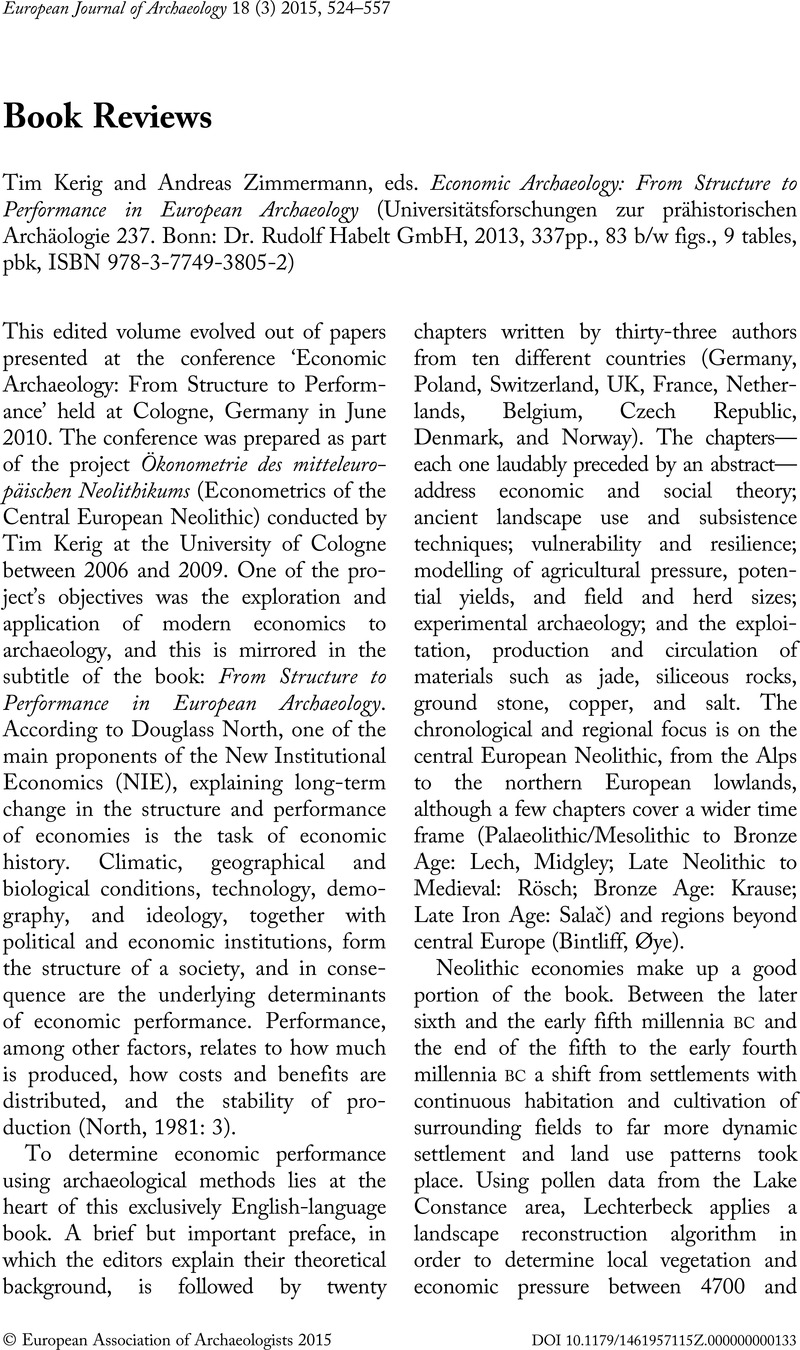No CrossRef data available.
Article contents
Tim Kerig and Andreas Zimmermann, eds. Economic Archaeology: From Structure to Performance in European Archaeology (Universitätsforschungen zur prähistorischen Archäologie 237. Bonn: Dr. Rudolf Habelt GmbH, 2013, 337pp., 83 b/w figs., 9 tables, pbk, ISBN 978-3-7749-3805-2)
Published online by Cambridge University Press: 25 January 2017
Abstract
An abstract is not available for this content so a preview has been provided. Please use the Get access link above for information on how to access this content.

- Type
- Book Reviews
- Information
- Copyright
- Copyright © 2015 the European Association of Archaeologists
References
Allison, P.M.
1999. Introduction. In: Allison, P.M., ed. The Archaeology of Household Activities. London: Routledge, pp. 1–18.Google Scholar
Carter, T., Dubernet, S., King, R., Le Bourdonnec, F.-X., Milič, M., Poupeau, G. & Shackley, M.S.
2008. Eastern Anatolian Obsidians at Çatalhöyük and the Reconfiguration of Regional Interaction in the Early Ceramic Neolithic. Antiquity, 82: 900–09.Google Scholar
Ensor, B.E.
2013. The Archaeology of Kinship: Advancing Interpretation and Contributions to Theory. Tucson: The University of Arizona Press.Google Scholar
Feinman, G.M.
2008. Economic Archaeology. In: Pearsall, D.M., ed. Encyclopedia of Archaeology, vol. 2. San Diego: Elsevier, pp. 1114–20.Google Scholar
Hirth, K. & Pillsbury, J., eds. 2013. Merchants, Markets, and Exchange in the Pre-Columbian World. Washington, DC: Dumbarton Oaks Research Library and Collection.Google Scholar
Lenerz-de Wilde, M.
1995. Prämonetäre Zahlungsmittel in der Kupfer- und Bronzezeit Mitteleuropas. Fundberichte aus Baden-Württemberg, 20: 229–327.Google Scholar
Lévi-Strauss, C.
1982. The Way of the Masks. Trans. Modelski, S.
Seattle: University of Washington Press.Google Scholar
North, D.C.
1990. Institutions, Institutional Change and Economic Performance. Cambridge: Cambridge University Press.Google Scholar
Pare, C.
2013. Weighing, Commodification, and Money. In: Fokkens, H. & Harding, A., eds. The Oxford Handbook of the European Bronze Age. Oxford: Oxford University Press, pp. 508–27.Google Scholar
Parkinson, W.A., Nakassis, D. & Galaty, M.L.
2013. Crafts, Specialists, and Markets in Mycenaean Greece: Introduction. American Journal of Archaeology, 117: 413–22.CrossRefGoogle Scholar
Rahmstorf, L.
2011. Re-Integrating ‘Diffusion’: The Spread of Innovations Among the Neolithic and Bronze Age Societies of Europe and the Near East. In: Wilkinson, T.C., Sherratt, S. & Bennet, J., eds. Interweaving Worlds: Systemic Interactions in Eurasia, 7th to the 1st Millennia BC. Oxford: Oxbow, pp. 100–19.Google Scholar
Skre, D.
2008. Post-Substantivist Towns and Trade, AD 600–1000. In: Skre, D., ed. Means of Exchange: Dealing with Silver in the Viking Age. Aarhus: Aarhus University Press (Kaupang Excavation Project Publication Series, vol. 2, Norske Oldfunn 23), pp. 327–41.Google Scholar


